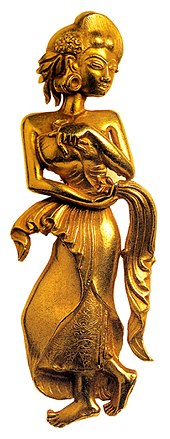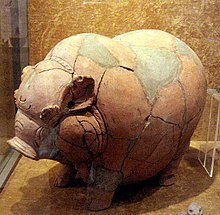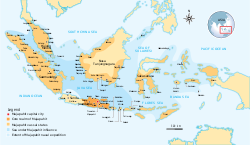Formation
After
defeating Melayu Kingdom in Sumatra in 1290,
Singhasari became the most powerful kingdom in the region.
Kublai Khan, the
Great Khan of the
Mongol Empire and the Emperor of the
Mongol Yuan Dynasty, challenged Singhasari by sending emissaries demanding tribute.
Kertanegara, the last ruler of Singhasari, refused to pay the tribute, insulted the Mongol envoy and challenged the Khan instead. As the response, in 1293, Kublai Khan
sent a massive expedition of 1,000 ships to Java.
By that time,
Jayakatwang, the
Adipati (Duke) of
Kediri, a vassal state of Singhasari, had usurped and killed Kertanagara. After being pardoned by Jayakatwang with the aid of Madura's regent, Arya Wiraraja;
Raden Wijaya, Kertanegara's son-in-law, was given the land of
Tarik timberland. He then opened that vast timberland and built a new village there. The village was named
Majapahit, which was taken from a fruit name that had bitter taste in that timberland (
maja is the fruit name and
pahit means bitter). When the Mongolian Yuan army sent by Kublai Khan arrived, Wijaya allied himself with the army to fight against Jayakatwang. Once Jayakatwang was destroyed, Raden Wijaya forced his allies to withdraw from Java by launching a surprise attack.
Yuan's army had to withdraw in confusion as they were in hostile territory. It was also their last chance to catch the
monsoon winds home; otherwise, they would have had to wait for another six months on a hostile island.
In AD 1293,
Raden Wijaya founded a stronghold with the capital Majapahit. The exact date used as the birth of the Majapahit kingdom is the day of his coronation, the 15th of
Kartika month in the year 1215 using the Javanese
çaka calendar, which equates to November 10, 1293. During his coronation he was given formal name
Kertarajasa Jayawardhana. The new kingdom faced challenges. Some of Kertarajasa's most trusted men, including
Ranggalawe,
Sora, and
Nambi rebelled against him, though unsuccessfully. It was suspected that the
mahapati (equal with prime minister)
Halayudha set the conspiracy to overthrow all of the king's opponents, to gain the highest position in the government. However, following the death of the last rebel
Kuti, Halayudha was captured and jailed for his tricks, and then sentenced to death.
Wijaya himself died in AD 1309.
According to tradition, Wijaya's son and successor,
Jayanegara was notorious for immorality. One of his sinful acts was his desire on taking his own stepsisters as wives. He was entitled
Kala Gemet, or "weak villain". Approximately during Jayanegara's reign, the Italian Friar
Odoric of Pordenone visited Majapahit court in Java. In AD 1328, Jayanegara was murdered by his doctor, Tanca. His stepmother, Gayatri Rajapatni, was supposed to replace him, but Rajapatni retired from court to become a
Bhikkhuni. Rajapatni appointed her daughter,
Tribhuwana Wijayatunggadewi, or known in her formal name as Tribhuwannottungadewi Jayawishnuwardhani, as the queen of Majapahit under Rajapatni's auspices. Tribhuwana appointed
Gajah Mada as the Prime Minister in 1336. During his inauguration Gajah Mada declared his
Sumpah Palapa, revealing his plan to expand Majapahit realm and building an
empire. During Tribhuwana’s rule, the Majapahit kingdom grew much larger and became famous in the area. Tribhuwana ruled Majapahit until the death of her mother in AD 1350. She was succeeded by her son,
Hayam Wuruk.
Golden age

The graceful
Bidadari Majapahit, golden celestial
apsara in Majapahit style perfectly describes Majapahit as "the golden age" of the archipelago.
Hayam Wuruk, also known as Rajasanagara, ruled Majapahit in AD 1350–1389. During this period, Majapahit attained its peak with the help of prime minister,
Gajah Mada. Under Gajah Mada's command (AD 1313–1364), Majapahit conquered more territories and become the regional power. According to the book of
Nagarakertagama pupuh (canto) XIII and XIV mentioned several states in
Sumatra,
Malay Peninsula,
Borneo,
Sulawesi,
Nusa Tenggara islands,
Maluku,
New Guinea, and some parts of
Philippines islands as under Majapahit realm of power. This source mentioned of Majapahit expansions has marked the greatest extent of Majapahit empire.
Next to launching naval and military expeditions, the expansion of Majapahit Empire also involved diplomacy and alliance. Hayam Wuruk decided, probably for political reasons, to take princess
Citra Rashmi (Pitaloka) of neighboring
Sunda Kingdom as his
consort.
The Sundanese took this proposal as an alliance agreement. In 1357 the Sunda king and his royal family came to Majapahit, to accompany and marry his daughter with Hayam Wuruk. However
Gajah Mada saw this event as an opportunity to demand Sunda's submission to Majapahit overlordship. The skirmish between the Sunda royal family and the Majapahit troops on Bubat square were unevitable. Despite the courageous resistance, the royal family were overwhelmed and decimated. Almost whole of the Sundanese royal party were viciously massacred.
Tradition mentioned that the heartbroken Princess committed
suicide to defend the honour of her country.
The Pasunda Bubat tragedy become the main theme of
Kidung Sunda, also mentioned in
Pararaton, however it was never mentioned in
Nagarakretagama.
The
Nagarakertagama, written in 1365 depict a sophisticated court with refined taste in art and literature, and a complex system of religious rituals. The poet describes Majapahit as the centre of a huge
mandala extending from
New Guinea and
Maluku to
Sumatra and
Malay Peninsula. Local traditions in many parts of Indonesia retain accounts in more or less
legendary form from 14th century Majapahit's power. Majapahit's direct administration did not extend beyond
east Java and
Bali, but challenges to Majapahit's claim to overlordship in outer islands drew forceful responses.
In 1377, a few years after Gajah Mada's death, Majapahit sent a punitive naval attack against a rebellion in
Palembang,
contributing to the end of the
Srivijayan kingdom. Gajah Mada's other renowned general was
Adityawarman, known for his conquest in
Minangkabau.
The nature of the Majapahit empire and its extent is subject to debate. It may have had limited or entirely notional influence over some of the
tributary states in included Sumatra, the
Malay Peninsula,
Kalimantan and eastern Indonesia over which of authority was claimed in the
Nagarakertagama.
Geographical and economic constraints suggest that rather than a regular centralised authority, the outer states were most likely to have been connected mainly by trade connections, which was probably a royal monopoly.
It also claimed relationships with
Champa,
Cambodia,
Siam, southern
Burma, and
Vietnam, and even sent missions to
China.
Although the Majapahit rulers extended their power over other islands and destroyed neighboring kingdoms, their focus seems to have been on controlling and gaining a larger share of the commercial trade that passed through the archipelago. About the time Majapahit was founded,
Muslim traders and
proselytizers began entering the area.
Decline
Following Hayam Wuruk's death AD 1389, Majapahit power entered a period of decline with conflict over succession. Hayam Wuruk was succeeded by the crown princess Kusumawardhani, who married a relative, Prince
Wikramawardhana. Hayam Wuruk also had a son from his previous marriage, crown prince
Wirabhumi, who also claimed the throne. A civil war, called
Paregreg, is thought to have occurred from 1405 to 1406,
of which Wikramawardhana was victorious and Wirabhumi was caught and decapitated. The civil war has weakened Majapahit grip on its outer vassals and colonies.
During the reign of Wikramawardhana, the series of
Ming armada naval expeditions led by
Zheng He, a
Muslim Chinese admiral, arrived in Java for several times spanned the period from 1405 to 1433. By 1430 Zheng He's expeditions has established Muslim Chinese and Arab communities in northern ports of Java such as in
Semarang,
Demak,
Tuban, and
Ampel, thus Islam began to gain foothold on Java's northern coast.
Wikramawardhana ruled to 1426 AD and was succeeded by his daughter
Suhita, who ruled from 1426 to 1447 AD. She was the second child of Wikramawardhana by a concubine who was the daughter of Wirabhumi. In 1447, Suhita died and was succeeded by
Kertawijaya, her brother. He ruled until 1451 AD. After Kertawijaya died,
Bhre Pamotan became a king with formal name Rajasawardhana and ruled at Kahuripan. He died in 1453 AD. A three-year kingless period was possibly the result of a succession crisis.
Girisawardhana, son of Kertawijaya, came to power 1456. He died in 1466 AD and was succeeded by Singhawikramawardhana. In 1468 AD Prince Kertabhumi rebelled against Singhawikramawardhana promoting himself king of Majapahit.
In western part of the crumbling empire, Majapahit found itself unable to control the rising power of the
Sultanate of Malacca that in mid 15th century began to gain effective control of
Malacca strait and expands its influence to Sumatra. Several other former Majapahit vassals and colonies began to released themself from Majapahit domination and
suzerainty.
Singhawikramawardhana moved the Kingdom’s capital further inland to Daha (the former capital of
Kediri kingdom) and continued his rule until he was succeeded by his son
Ranawijaya in 1474 AD. In 1478 AD he defeated Kertabhumi and reunited Majapahit as one Kingdom. Ranawijaya ruled from 1474 AD to 1519 AD with the formal name Girindrawardhana. Nevertheless, Majapahit's power had declined through these dynastic conflicts and the growing power of the north-coastal kingdoms in Java.
Dates for the end of the Majapahit Empire range from 1478 (that is, 1400
Saka, the ends of centuries being considered a time when changes of dynasty or courts normally ended
) to 1527. The year is marked among Javanese today with
candra sengkala "
sirna ilang kertaning bumi" (the wealth of earth disappeared and diminished) (
sirna = 0,
ilang = 0,
kerta = 4,
bumi = 1). According Jiyu and Petak inscription, Ranawijaya claimed that he already defeat Kertabhumi
and move capital to
Daha. This event lead the war between
Sultanate of Demak and
Daha, since Demak ruler was the descendants of Kertabhumi. The battle was won by Demak in 1527.
A large number of courtiers, artisans, priests, and members of the royalty moved east to the island of
Bali. The refugees probably flee to avoid Demak retribution for their support for Ranawijaya against Kertabhumi.
With the fall of Daha crushed by Demak in 1527, the Muslim emerging forces finally defeated the remnant of Majapahit kingdom in the early 16th century.
Demak under the leadership of Raden (later crowned as Sultan) Patah (Arabic name: Fatah) was acknowledge as the legitimate successor of Majapahit. According to Babad Tanah Jawi and Demak tradition, the source of Patah's legitimacy because, their first sultan, Raden Patah is the son of Majapahit king Brawijaya V with a Chinese concubine. Another argument supporting Demak as the successor of Majapahit; the rising Demak sultanate was easily to be accepted as the nominal regional ruler, as Demak was the former Majapahit vassal and located near the former Majapahit realm in Eastern Java.
Demak established itself as the regional power and the first Islamic sultanate in Java. After the fall of Majapahit, the Hindu kingdoms in Java only remained in
Blambangan on eastern edge and
Pajajaran in western part. Gradually
Hindu communities began to retreat to mountain ranges in East Java and also to neighboring island of
Bali. A small enclave of
Hindu communities still remain in
Tengger mountain range.












